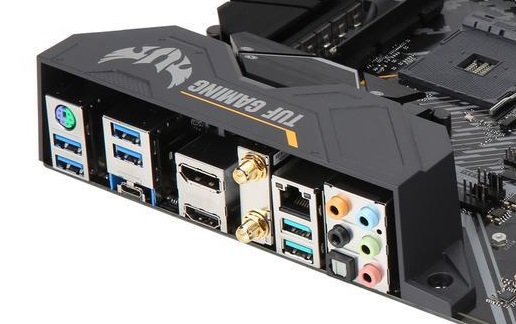The AMD X570 Motherboard Overview: Over 35+ Motherboards Analyzed
by Gavin Bonshor on July 9, 2019 8:00 AM ESTASUS TUF Gaming X570-Plus & X570-Plus WIFI
The ASUS TUF Gaming X570-Plus and TUF Gaming X570-Plus Wi-Fi motherboards both contain the same core componentry with a 12+2 phase power delivery, actively cooled X570 chipset heatsink, a Realtek S1200A HD audio codec, and both feature the new Realtek L8200A Gigabit LAN which is exclusive to ASUS at present. The only difference between the two models is that the TUF Gaming X570-Plus WIFI includes an Intel AC 9260 802.11ac wireless interface with BT 5.0 support included.
On the design, the aesthetic is reminiscent of previous TUF Gaming branded models with a grey and black patterned printing on the PCB, with grey industrial looking heatsinks. There are four memory slots with support for ECC and non-ECC DDR4 memory with a maximum capacity of up to 128 GB. The ASUS TUF Gaming X570-Plus pairing also includes two full-length PCIe 4.0 slots which run at x16 and x16/x4.
Included on the rear panel is an HDMI 1.4b, and DisplayPort video output, with two USB 3.1 G2 Type-A, and one USB 3.1 G2 Type-C port; also featured are four USB 3.1 G1 Type-A ports. A new addition to Realtek's NIC line up and exclusive to ASUS is an L8200A Gigabit NIC, with the WIFI model including an Intel AC 9260 802.11ac wireless interface. The five 3.5 mm audio jacks and S/PDIF optical output are controlled by a Realtek ALC1200A HD audio codec, and finishing off the rear panel is a PS/2 combo port for legacy keyboard and mice.
Both the ASUS TUF Gaming X570-Plus and TUF Gaming X570-Plus WIFI models represent its gaming-inspired entry level; ASUS rebranded the TUF series from durable and robust models, to more accessible models with a more modest outlay when compared to the Strix series. The ASUS TUF Gaming X570-Plus has an MSRP of $170, while the WIFI enabled version is slightly more expensive with an MSRP of $185.












225 Comments
View All Comments
icf80 - Thursday, July 25, 2019 - link
All x570 boards supports: 4 x DDR4 DIMM sockets supporting up to 128 GB (32 GB single DIMM capacity) of system memorycroc - Friday, July 26, 2019 - link
Now find me one of these ddr4 1x32 dimms @ 3400 speed to support the speed of the CPU. What they support and what I can buy are often two different things All x299 boards support DDR4 up to 4200, at whatever size you can afford, with quad channel support. And there are 8 dimm slots...Inexpensive is often not cheap. Expensive is often cheaper than the non-existant.
CoachAub - Thursday, July 25, 2019 - link
I have an Aorus AX370 Gaming 5 mobo. With the latest BIOS update for Ryzen 3000 series (f40), I now have the option to select PCI-e 4.0. It has had 3.0 as an option as long as I can remember. It seems some mobo mfg are supporting it, even though AMD won't officially.max347 - Friday, August 2, 2019 - link
Release date on the Crosshair Impact?madseven7 - Saturday, August 3, 2019 - link
In your chart of motherboards listing biosflashback you missed the ASUS ROG Strix X570-E Gamingsoltys - Wednesday, August 7, 2019 - link
According to Asrock website, ASRock X570 Steel Legend has ALC1220dforrestvc - Sunday, August 11, 2019 - link
Will there being only three audio jacks prevent me from properly connecting a 5.1 speaker system?svan1971 - Saturday, August 17, 2019 - link
Why are the boot times with pcie 4.0 m.2 so dam slow ? My 5 year old Asrock boots 3 times faster?Tinkertron - Sunday, August 18, 2019 - link
I still haven't seen this board hit the market yet. ASRock has release 2 version and Gigabyte has 1 on the mini-ITX release already. I also notice that the ROG Strix doesn't show a fan cooled over the chipset. All the makers are adding fans over the chipset. How is ASUS getting away without doing this? Could this be the reason why ASUS hasn't release theirs yet?Crashing Bore - Sunday, December 8, 2019 - link
The Gigabyte AORUS Ultra with 3rg gen ryzen delivers pcie4 x16 + PCIE4 x8 + PCIE4 x4 for its three PCIE 16 slots - not 16/8+8/8+8+4 as described - it is 16+8+4 full time, regardless of the slots populated. This is so also for other boards in their stack, and offers point of differentiation allowing later population of, say, thunderbolt3 in the second slot without slow down the main graphics card pipeline.